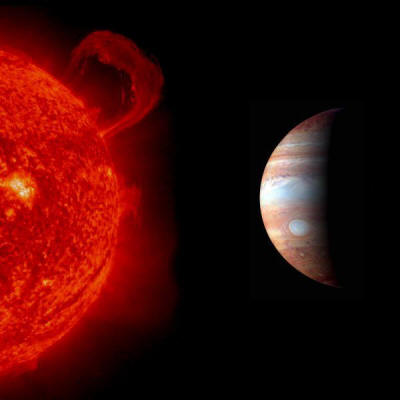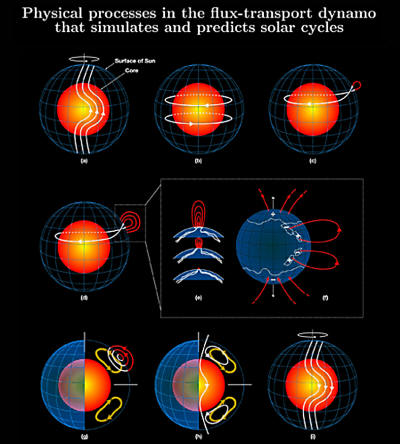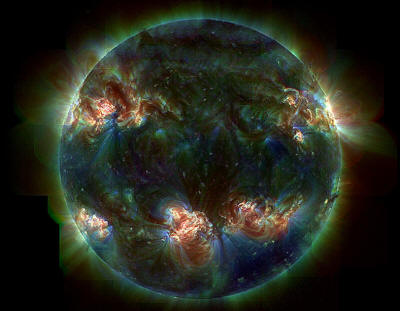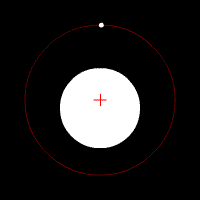|

by Mike Bara
2008
from
EnterpriseMission Website

A new paper by a pair of Australian
astronomers has provided a flat-out, indisputable confirmation of
the Hoagland\Torun Hyperdimensional Physics Model, first proposed in
their 1989 paper, “The
Message of Cydonia.”
The new paper, titled “Does
a Spin Orbit Coupling Between the Sun and the Jovian Planets Govern
the Solar Cycle?” points out
a resonant, synchronized relationship between the Sun’s periodic
peak sunspot cycles and the orbital positions of the Jovian planets
- Jupiter and Saturn.
Careful readers of
Dark Mission will note that this
exact relationship, is both implicitly and explicitly predicted in
Chapter 2 of our book.
While the mechanical cause of the increased sunspot activity is
reasonably well understood (it’s caused by the sun’s rotation), the
driving force linking this spin and the sunspot cycle has remained a
mystery. According to Dr. Ian Wilson of the University of
Southern Queensland, which published the new research, observations
by solar astronomers have concluded that the equatorial regions of
the sun rotate slightly more rapidly than the polar regions (below -
b).
This differential rotation winds up the
sun’s magnetic field lines (which stretch between the two poles)
like a set of tightening rubber bands (below-a).

Eventually, the field lines work their
way to the surface of the sun because the concentrated magnetic flux
is more buoyant than the surrounding solar surface (above-c).
This subsequently causes
sunspots,
solar flares and
coronal mass ejections, which tend
to cluster around
the "tetrahedral" 19.5° latitudes
(north and south!) at the peak of this cycle (below).

This peak is called “solar maximum”
because all the visible spots, flares, etc. are most numerous at
this time, after which the magnetic poles reverse and the cycle
begins again.
There has historically been a recognized connection between the
frequency of sunspot activity (the total number of spots) and the
movement of the sun in relation to solar system's “barycentre” - or,
center of mass (below and far below). This is driven primarily by
the combined gravitational forces of Jupiter and Saturn, and to a
far lesser extent, the other planets.

But the big problem is that there is no
conventional explanation for exactly how this influence occurs.
"There are really only two possible
interactions, and neither of them is feasible," Dr.
Wilson said in an interview.
"Tidal forces are too tiny. They can only produce a movement of
about a millimeter on the surface of the sun.
"The alternative, that the sun's motion about the centre of mass
should be able to generate internal motions within the sun,
violates Einstein's equivalence principle...."

What separates this new research from
previous interpretations is the observation that the relative
positions of Jupiter and Saturn somehow affect this
cyclical energy variation.
To quote from an article about Wilson et
al.’s paper appearing on the
Australian ABC science website:
“The authors believe the tiny
gravitational tugs of Jupiter and Saturn speed up or slow down
the sun's orbital motion about the centre-of-mass, when they are
aligned or separated by an angular distance of 90 degrees.
“They say that when the sun's orbital motion changes, so too
does its equatorial rotation rate, which provides strong
circumstantial evidence that there is a spin-orbit coupling
mechanism operating between Jupiter and Saturn and the sun.
“The authors propose that this spin-orbit coupling takes the
form of a 9:8 resonance, with the 179 year alignment cycle of
the Jovian planets being equal to nine alignments of Jupiter and
Saturn and eight
22-year Hale cycles.
“The extent to which Jupiter and Saturn affect the sun's motion
may impact on the strength of sunspot activity throughout its
solar cycle.
"But Wilson is cautious.
"It is one thing to show an association and quite another to
show cause and effect. We have to be very careful, but we will
know in a few years."
Of course, the reality is that as long
as solar astronomers keep searching for a conventional
“gravitational” effect for this resonance synchronization, they
will never fully understand what is causing the differential
rotation - and the consequent variable excess energy from the sun.
In the conventional view, it is mass - and therefore "gravity" -
which is the only viable influence on solar energy output and
motion.
But in the Hyperdimensional Physics Model, “the tail wags the
dog” - in the form of angular momentum.
It is an undeniable fact that Jupiter and Saturn -
which possess only a tiny fraction the solar system’s total mass
compared to the sun – are, in fact, a huge influence on the sun
itself (and all of the other planets as a consequence). This is
because they conversely possess most (almost 99%) of the solar
system’s total bulk angular momentum.
In the Hyperdimensional Model, it is this angular momentum -
mainly from these two massive planets, transmitted through the
“Hyperdimensional aether” - which ultimately causes the sun’s
differential rotation.
To quote directly from Dark Mission, Chapter 2:
“... changes in one
gravitationally-connected system on a large scale, like the
planetary scale of a solar system, can therefore have an
instantaneous, measurable effect on other bodies in the same
system - providing there is a "resonance condition" (a matched
connection) between those two objects via hyperspace.
Thus, the Hyperdimensional Model
argues that everything, even widely separated three-space
objects like remote planets, are ultimately connected through
this four-space interaction; meaning that a cause in one place
(like Jupiter) can have an effect in another (like the sun) -
without any measurable 3D force (such as an electromagnetic
wave) having measurably traversed the three-space distance in
between...."
In this "classical" Einsteinian view
of physics (after 1905...), there is no "aether” - as it was
called in Maxwell’s day (mid-1800's) - to carry electromagnetic
radiation's transverse waves across the vacuum.
In the Hyperdimensional Model
(circa 1983...), the aether is back - as,
"the actual transformation medium"
between the higher spatial realities and our dimension - through
something called "the
torsion field…”
This whole notion, that the changing
(orbital) configuration of a planets (or star’s) system members
relative to the “primary” can have an effect on its total energy
output, is revolutionary to current thinking, but hardly without
precedent.
In the 1940s, the Radio Corporation of America (RCA)
hired John Nelson, a young electrical engineer, in an effort
to improve the reliability of short-wave radio communications around
the Earth. Such radio transmissions had been observed to be more
reliable in the "lulls" in between solar activity associated with
"peak" sunspot years.
To his surprise, Nelson (via a solar observatory he built himself on
the roof of a downtown New York skyscraper - below) soon
specifically correlated this rising and falling radio interference
with not only the sunspot cycle, but with the motions of the major
planets of the solar system!
Nelson found, to his increasing
astonishment, a very repeatable -
in essence, "astrological"
- correlation... between the inexorable orbits of the planets
(especially Jupiter, Saturn, Uranus and Neptune - which hold
essentially all the solar system's known angular momentum) and major
radio-disturbing eruptions on the sun.

The Hyperdimensional Model
finally provides a comprehensive theoretical explanation - a
"linking mechanism" - for these (to most astronomers) still
embarrassing, decades-old RCA observations.
For, in essence, what John Nelson had
rediscovered was nothing short of ”hyperdimensional astrology" - the
ultimate, very ancient, now highly demonstrable angular
momentum/torsion foundations behind the fundamental (though
unseen...) influences of the sun and planets on our lives.
For over 30 years, based only on the heliocentric positions of the
planets, John Nelson was able -
with over 90% accuracy - to
successfully predict sunspots, solar flares and geomagnetic storms -
something not possible by any other current scientific means!
On the latter point, Nelson also "rediscovered" something else:
"... it is worthy of note that in
1948, when Jupiter and Saturn were spaced by 120º, and solar
activity was at a maximum, radio signals averaged of far higher
quality for the year than in 1951 with Jupiter and Saturn at
180º and a considerable decline in solar activity.
In other words, the average quality
curve of radio signals [reflected by the Earth's ionosphere]
followed the cycle curve between Jupiter and Saturn rather than
the sunspot curve...”
These decades-old observations are very
telling... not only confirming Jupiter and Saturn as the primary
drivers behind the sun's known cycle of activity (in the
Hyperdimensional Model...), but strongly implying an additional
direct effect of their changing angular relationship on the
electrical properties of Earth's ionosphere.
This, of course, is totally consistent
with these changing planetary geometries affecting not just the sun,
but the other planets simultaneously as well - just as
"conventional" astrologers have claimed - but, in actuality, via
Maxwell's "changing scalar potentials” (i.e. torsion fields...).
At this point, then, only the Hyperdimensional Theory:
-
Points to the deepest
implications of the simple astronomical fact that the tail
“does wag the dog" - that the planets in this Physics are
fully capable of exerting a determinant influence on the sun
- and on each other - through their disproportionate ratio
of total solar system angular momentum: over 100 to 1, in
the (known) planets' favor.
-
Possesses the precise physical
mechanism - via Maxwell's "changing quaternion scalar
potentials" (also known now as the “torsion spin field”) -
accounting for this anomalous planetary angular momentum
influence.
-
Has already publicly identified,
at the United Nations in 1992, a blatant geometric clue to
this entire hyperdimensional solar process: the maximum
sunspot numbers (those large, relatively cool, rotating
vortices appearing on the solar surface), rising, falling
and methodically changing latitude, during the course of the
familiar twenty-two-year solar cycle—and peaking every
half-cycle (around eleven years), at the solar latitude of
19.5º.
Don’t you just love it... when a good
theory comes together so elegantly?
Make no mistake, if this Wilson et al. paper is widely accepted,
somebody will eventually concoct a tenuous conventional
"explanation" to rationalize the observations.
But that theory will hold no more weight
than the absurd “radiation degradation” idea that was floated about
a few years ago to explain
Iapetus' "...60,000-foot-high
equatorial wall."
At some point, modern physicists will just have to face the
unpleasant reality:
|






